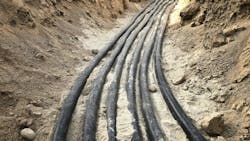Robotic Innovations in Underground Distribution Line Installations
One of my favorite weekly newsletters just hit my inbox and it was full of news about robots and robotics. The main headline was about utilizing robotic worms to simplify underground distribution line installations, but then a better clickbait headline got me. It said, “robots race against humans in mini-marathon.” I clicked on it, how could I ignore that? Turns out there was a half-marathon race. It was held for both humans and bipedal robots in Beijing a few months ago. It was the first time robots and humans took part in a racing event, but the humans and the robots did not actually race against each other.
They each had a separate race with the robots taking the field after the humans moved out. Being a first time event, the robot developers learned a lot about the rigors of competition. The robots had plenty of problems, nevertheless the crowd witnessed an exciting event. Of the 21 robots entered, only six finished the race. One collapsed a few steps beyond the starting line, one fell over at the starting, and another crashed into a barrier. In spite of all that, I’m sure their learning curve took a big jump upward. Racing has a way of boosting technology and I can’t wait to see what happens with the next race!
Improving Undergrounding
Getting back to the robotic worms that initially caught my eye, they’re part of the DOE (Department of Energy) three-year GOPHURRS (Grid Overhaul with Proactive, High-speed Undergrounding for Reliability, Resilience, and Security) program. DOE is spending US$ 34 million to fund 12 projects with an eye to improving undergrounding technologies. DOE pointed out “there are no fast or cheap methods for undergrounding lines in existence yet.” That’s why DOE is interested in advancing the technology.
DOE noted, the U.S. distribution system has “over 5.5 million line-miles (8.8 million km)” with the majority being overhead. With about 90% of outages happening on the distribution system, putting them underground is a major goal for grid modernization. Using today’s open trenching methods the cost can range from US$1.5 million to US$6 million per mile to underground the average distribution line. When we start talking about transmission lines, the costs per mile become astronomical!
Before someone writes to tell me there’s also the trenchless process known as horizontal directional drilling (HDD), they’re not fast or cheap either. Also, it’s well-known they damage anything in their path. That is why Sandia National Labs is taking part in the GOPHURRS program with a project of its own. Sandia is developing “a real-time, drill-mounted, cross-bore detector using ground penetrating radar to reduce the risk of damaging existing underground infrastructure.” It can see cross-bore problems and avoid them, which should be a huge plus for keeping the below grade infrastructure intact.
Worm-Like Robots
There are some really interesting projects under this GOPHURRS banner, but it’s worm-like robotics that attracted my attention to the subject in the first place. There are a couple of bio-inspired projects that are capturing interest in the program. The two most popular examples are the worm and the mole, but it wouldn’t surprise me to find other types of burrowing critters inspiring designers. Let’s look at a couple.
Case Western Reserve University is developing “a worm-inspired construction tool.” It’s a self-propelled robotic sleeve device that moves much like an earthworm. This peristaltic motion uses an expansion and retraction method of movement to dig while laying conduit as it goes. The developers say it’s much cheaper, more accurate, and can turn in a few feet rather than the hundreds of feet needed by today’s HDD methods.
GE Vernova Advanced Research is developing a robotic worm tunneling construction tool they call SPEEDWORM. GE’s designers say, “It mimics the natural movements of earthworms and tree roots.” It digs and installs conduit and cables for underground distribution power lines and can be deployed from a standard pickup truck eliminating complexity.
Cornell University is developing “a mini-mole combustion-power soil fracturing head to minimize environmental disruption.” They reported it uses soft robotics for improved steering and movement. It’s capable of tunneling, laying conduit, and installing cables without damaging the surface.
Robotics have improved many processes and now they’re going to improve some smart grids applications. It’s a promising technology that seems like a fast, cheap, and safe method to install power lines underground. It’s certainly needed with all the new challenges coming our way. It’s definitely a trending technology worth tracking!
About the Author
Gene Wolf
Technical Editor
Gene Wolf has been designing and building substations and other high technology facilities for over 32 years. He received his BSEE from Wichita State University. He received his MSEE from New Mexico State University. He is a registered professional engineer in the states of California and New Mexico. He started his career as a substation engineer for Kansas Gas and Electric, retired as the Principal Engineer of Stations for Public Service Company of New Mexico recently, and founded Lone Wolf Engineering, LLC an engineering consulting company.
Gene is widely recognized as a technical leader in the electric power industry. Gene is a fellow of the IEEE. He is the former Chairman of the IEEE PES T&D Committee. He has held the position of the Chairman of the HVDC & FACTS Subcommittee and membership in many T&D working groups. Gene is also active in renewable energy. He sponsored the formation of the “Integration of Renewable Energy into the Transmission & Distribution Grids” subcommittee and the “Intelligent Grid Transmission and Distribution” subcommittee within the Transmission and Distribution committee.
